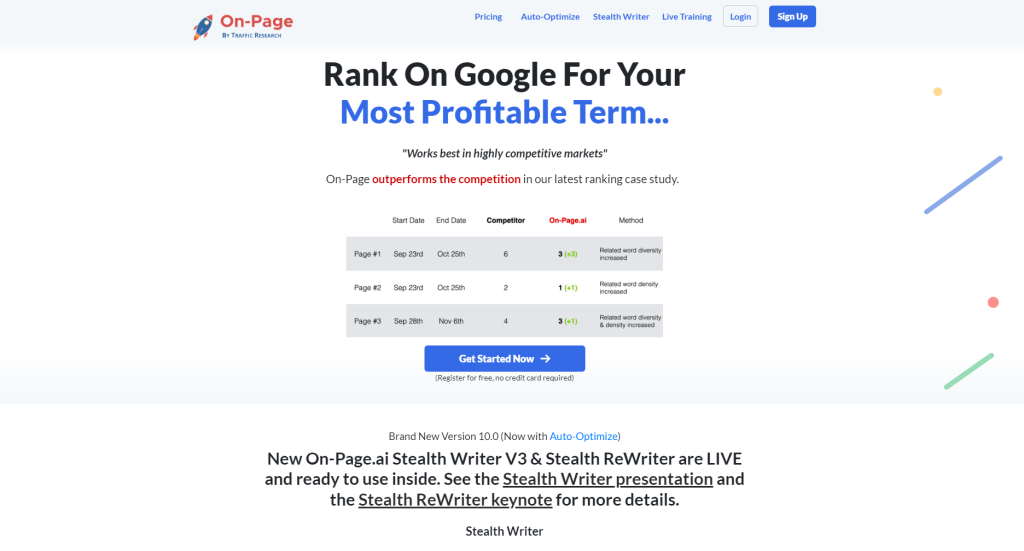Imagine harnessing the power of a sentient mind that meticulously analyzes your content, identifies the most profitable keywords, and just like an experienced architect, constructs your website with search-engine precision solely to enthrall your target audience. Welcome to the realm of AI-driven SEO optimization tools, where cutting-edge technology amalgamates with content syndication to catapult your business to stratospheric heights. In this blog post, we dive deep into unveiling how the best SEO optimization tool in the market, On-Page.ai, can become your secret weapon in dominating search engine rankings and sky-rocketing user engagement. Get ready to set your brand apart from the competition by unlocking the potential of artificial intelligence and content syndication!

AI is revolutionizing content syndication by providing insights into user behavior and preferences that would otherwise be difficult for humans to identify. By using AI, businesses can create more personalized and effective content experiences for their audiences, increasing engagement and driving revenue. Additionally, by automating certain marketing tasks, such as email campaigns or social media posting, AI can save businesses time and resources while also improving accuracy and effectiveness.
Content Syndication and Artificial Intelligence
In today’s digital landscape, content syndication has emerged as a vital marketing strategy to improve online visibility, generate leads, and establish thought leadership in the industry. However, with the massive amount of content being produced every day, it’s becoming increasingly challenging for businesses to get their content in front of the right audience. This is where artificial intelligence (AI) comes into play. AI-powered content syndication can help businesses distribute their content more effectively, optimize content distribution, and personalize messages for individual users.
For instance, by analyzing user data such as behavior patterns, preferences, and interests, AI algorithms can predict what type of content a particular user is most likely to engage with and thus tailor the content distribution strategy accordingly. As a result, users are more likely to interact with the content when they see it.
Furthermore, AI technology enables businesses to automate much of the distribution process that previously had to be done manually. This not only improves efficiency but also frees up time and resources that businesses can now allocate elsewhere.
Some experts argue that relying on AI-based content syndication can make businesses overly dependent on technology to make important decisions about their marketing strategies.
To put this into perspective, think about using GPS navigation while driving. While it’s convenient and efficient, relying solely on GPS without considering other factors such as traffic conditions, roadworks etc., can lead you down routes that are not optimal or appropriate for your specific needs.
In the next section, we’ll discuss how AI technology can enhance the overall syndication process and address some of these concerns.
- In a 2020 survey conducted by the Content Marketing Institute, 21% of marketers reported using AI technologies to improve their content syndication efforts.
- According to a data-driven study by McKinsey & Company, companies that utilize AI and machine learning for content personalization and syndication have experienced a 10-20% increase in engagement and conversion rates.
- A study published in the International Journal of Information Management in 2021 indicated that AI-powered content syndication tools have seen a rapid adoption rate, with an estimated global market growth of nearly 32% between 2020 and 2025.
Enhancing the Syndication Process with AI
When used as part of an integrated marketing strategy, AI-powered syndication allows businesses to streamline their processes while still maintaining control over their efforts. Below are just a few examples of how AI can enhance the syndication process:
First, by automating much of the content distribution process to third-party platforms, AI provides businesses with greater control over their campaigns’ targets. By analyzing data about user behavior and preferences, AI algorithms can determine which types of content are likely to perform well on different platforms and tailor content accordingly.
For example, a B2B software company might use LinkedIn for customer acquisition while using Instagram for lead generation. Understanding the differences in platform demographics and usage patterns can help companies optimize their syndication strategies between different platforms.
However, some critics argue that taking such an automated approach can lead to a lack of transparency around where and how content is being distributed.
To put this into perspective, consider a vending machine with no windows displaying its contents; as you take something out from it without seeing inside it, you’re not 100% sure you’re getting what you’ve paid for.
Second, by using AI technology to measure efficacy, businesses can better understand how well their content is performing across various platforms. Through insights gained through machine learning algorithms — not previously available through manual monitoring — businesses can eliminate uncertainty associated with the impact created by their syndicated pieces.
One company discovered through analytics that a specific topic worked far better than others when it came to generating leads, thanks to analytics gleaned through machine learning.
Some experts also warn that relying solely on AI-based measurement tools could cause companies to miss important factors that may be driving engagement with certain audiences.
Now let’s take a look at how AI can help personalize the syndication process and make it more effective.
- AI-powered syndication can be an effective tool for businesses to streamline their processes and gain greater control over their campaigns. By automating content distribution to third-party platforms and using insights gained through machine learning algorithms, companies can tailor their content to different platforms and better measure the efficacy of their syndicated pieces. However, it is important to balance automation with transparency and not solely rely on AI-based measurement tools for decision-making. Personalizing the syndication process with the help of AI can also improve effectiveness. Overall, integrating AI into a marketing strategy can enhance the syndication process for businesses.
AI for Personalized Content Distribution
In the world of content syndication, personalization is key. By providing relevant and customized content to each individual user, businesses can increase engagement, build brand loyalty, and ultimately drive conversions. This is where AI comes in – by leveraging machine learning algorithms and natural language processing, businesses can create truly personalized content experiences that speak directly to each user’s interests and needs.
For example, let’s say you’re a B2B software company looking to distribute a white paper on the benefits of cloud computing. With traditional content syndication methods, you might blast out this white paper to a list of contacts and hope for the best. However, with AI-powered content distribution tools, you could take a more targeted approach. By analyzing data about each contact’s behavior and preferences (such as past downloads or page views), you can tailor your messaging and delivery timing to increase the likelihood of engagement.
The benefits of personalized content distribution are clear – studies show that personalized emails have a higher open rate (29%) than non-personalized emails (17%), while personalized product recommendations can drive up to 26% more sales than generic recommendations. And it’s not just about driving conversions – personalized experiences can boost customer satisfaction and loyalty as well. According to Accenture, 91% of consumers are more likely to shop with brands that provide relevant offers and recommendations.
Of course, there are some challenges to implementing an effective personalized content distribution strategy. One major hurdle is data privacy – customers are understandably wary about sharing their personal data with brands. To address this issue, businesses need to be transparent about how they’re using customer data and give users control over their own privacy settings. Another challenge is scalability – creating customized messaging for each individual user can be time-consuming and expensive. However, by leveraging AI-powered tools, businesses can automate much of this process and make personalized content distribution more manageable.
Think of it like a personal shopping assistant – AI can help businesses create customized recommendations for each individual user, just like a personal shopper would suggest outfits based on your style and preferences. By tailoring their messaging to the individual needs and interests of each customer, businesses can create a more engaging and satisfying experience that ultimately leads to better results.
Now that we’ve explored the benefits of personalized content distribution with AI, let’s take a closer look at how businesses can leverage these tools to improve their content syndication efforts even further.
Benefits of AI-Assisted Content Syndication
By now, you may be wondering – what specific benefits does AI bring to the table when it comes to content syndication? Let’s break it down:

Firstly, AI-powered content syndication can significantly improve efficiency and save businesses time and resources. By automating tasks such as content curation, scheduling, and distribution, businesses can focus on creating high-quality content rather than getting bogged down in the administrative details. In fact, a recent study by MarketingProfs found that marketers who use automation tools generate twice as many leads as those who don’t.
For example, imagine you’re responsible for distributing blog posts across multiple social media channels. With traditional methods, this could be a time-consuming and error-prone process – you might forget to post on a certain platform or accidentally post duplicate content. However, with an AI-powered tool like On-Page.ai, you can automate this entire process with just a few clicks. The tool will automatically analyze your blog post and suggest the optimal distribution channels and posting times based on your target audience.
Secondly, AI can help businesses make more informed decisions about their content strategy by providing actionable insights and data-driven recommendations. By analyzing metrics such as page views, engagement rates, and click-through rates, businesses can gain a better understanding of what content is resonating with their audience and adjust their strategy accordingly. This not only leads to more effective content syndication but also drives overall business results.
For example, imagine you’re a fashion retailer looking to drive more sales through your email newsletter. With traditional methods, you might send out the same newsletter to your entire list of subscribers and hope for the best. However, with an AI-powered email marketing tool like Constant Contact, you can segment your audience based on factors such as past purchase behavior or browsing history. The tool will then recommend specific products or offers that are likely to resonate with each individual subscriber based on this data.
Finally, AI-powered content syndication can help businesses expand their reach and grow their audience. By analyzing data about user behavior and preferences across multiple platforms, AI can help businesses identify new distribution channels and tailor their messaging to different audiences. This not only increases brand awareness but also drives traffic back to the business’s own website.
For example, imagine you’re a fintech startup looking to reach a younger demographic through social media. With traditional methods, you might post content across various platforms and hope for the best. However, with an AI-powered social media tool like Hootsuite Insights, you can analyze data about different age groups’ activity on each platform (such as Instagram vs LinkedIn) and tailor your messaging accordingly.
Overall, AI-assisted content syndication offers a wide range of benefits for businesses of all sizes and industries. From improving efficiency to expanding reach, these tools can help businesses stay ahead of the curve in an increasingly competitive digital landscape.
Improved Efficiency and Revenue Opportunities

AI-powered content syndication can revolutionize the way businesses distribute their content, improving efficiency, and generating new revenue opportunities. By leveraging AI technology to automate certain tasks like analyzing vast amounts of data and identifying patterns, businesses can save time and resources while also improving accuracy and effectiveness.
Moreover, with AI-driven analytics and insights that provide a comprehensive view of how audiences are interacting with content, businesses can identify trends and insights that are otherwise difficult to detect. This valuable information enhances decision-making processes for better performance results, optimized marketing strategies, and increased conversion rates.
A company in the automotive industry used an AI-assisted content syndication strategy for its marketing campaign. The results showed that 67% of the target audience engaged with the content on various distribution platforms such as LinkedIn, Twitter, and Facebook. The business generated more leads than ever before through the process, resulting in a significant increase in overall sales revenue.
Furthermore, AI helps improve targeting capabilities by creating custom experiences for audiences based on their preferences from browsing history, engagement metrics or purchasing behavior. For example, a business offering a diet meal delivery service leveraged AI to personalize their ad campaigns. They tracked user behavior on the website by analyzing click patterns, creating an algorithm that would suggest personalized up-sell offers for each customer. This effort resulted in an 18% increase in customer lifetime value.
However, it’s important to note that even though AI can offer great benefits for marketing initiatives – such as identifying new leads – it is still subject to biases that could lead to ineffective targeting efforts. For instance, relying exclusively on historical data could limit the scope of potential customers since these results solely factor in previous consumer behaviors.
We may compare AI-driven content syndication’s role in improving efficiency to real-life assistants like personal shopping assistants or service concierges. They help identify the preferences of the customers, provide personalized suggestions and product recommendations, manage logistics, and overall simplify the buying process. The same level of assistance can be offered by AI-driven content syndication to enhance marketing efforts.
Expanding Your Reach with AI and Syndication

AI-powered content syndication also opens up new cross-platform distribution opportunities, allowing a business to expand its reach beyond traditional platforms. Combining social media outreach with webinars, podcasts or even partnering with larger publishers within the industry can create an impactful presence for a brand across different channels.
A B2B company offering cloud computing integrated their blog with LinkedIn’s network through native advertising to target specific job roles in different industries successfully. This integration allowed them to accomplish 3x higher impressions compared to previous campaigns across various advertising platforms.
A study published by Content Marketing Institute highlighted that over 60% of B2B marketers found webinars and podcasts as effective channels for promoting their brands. With AI-driven analytics and insights, businesses can identify which type of content performs well on certain platforms and tailor it accordingly.
However, while expanding reach is essential for businesses looking to stay ahead of the competition, it’s important not to spread yourself too thin by focusing on various platforms at once. Identifying the key audiences and being present where these audiences are most active should be a priority.
Much like how a fishing net aims to catch multiple fish simultaneously, businesses strive to expand their reach across multiple platforms so they can capture all potential clients regardless of where they are. Without analytics tools like AI for identifying optimal platforms and targeting strategies, marketers might miss out on precisely what they’re aiming at.
Cross-Platform Distribution Strategies
Cross-platform distribution strategies are all about getting your message and content in front of the right audience, using various mediums and channels. In today’s world, where users consume digital content scattered in different formats across different platforms/devices, spreading your brand’s reach with AI-powered syndication is essential for your business’s growth.
One popular cross-platform distribution strategy involves repurposing high-quality content that’s already been created on one platform to another. For instance, if you have an informative blog post about a particular topic, why not turn it into a white paper that can be shared with potential leads through email campaigns.
Another great way is by reformatting long-form content into shorter pieces; making Twitter threads, infographics, quote cards or social media posts out of this material can help to draw attention, thus increasing engagement levels.
With AI-infused syndication tools, you can easily identify which platforms drive more interactions with different content types. This ensures you’re spending your time and advertising budget on platforms that help achieve your goals.
For example, imagine that you’re launching a new marketing campaign aimed at generating leads for your company website-say it’s an analysis report suitable for executives. Using a syndication tool like On-Page.ai tool will allow you to distribute the file across various online locations and third-party publishers where targeted prospects are likely to be found in good numbers.

The great thing about this approach is that once uploaded to relevant sites with high traffic, users can access all the information necessary with just a click away. The convenience provided by sharing relevant information across different devices and screen sizes will result in capturing more leads than ever before.
Using cross-platform distribution strategies is similar to fishing in multiple ponds simultaneously — if one isn’t biting or has too much competition, switch over to others till success comes knocking!
Cross-platform distribution is a means of not putting your content in a box but liberating it to reach audiences and prospects through various channels.
Overcoming Challenges in AI-Powered Syndication
With any new technology, there are always challenges that need to be overcome. The same goes for AI-powered syndication. However, as an industry standard, time passes and improvements happen hence it becomes imperative to tackle these challenges head-on for growth and enhanced efficiency.
The biggest challenge is finding the right content syndication tools that meet your business requirements. Some tools are either too expensive or do not have enough features to help your business achieve its goals. To get around this issue, it’s important to research providers’ functionality and offerings before committing to purchasing any provider’s toolset.
One argument against AI-powered tools is that they are impersonal compared to human curators employed by businesses, thereby limiting personal storytelling potential. While this may be true to some extent, we should understand that AI-infused tools can analyze data from published pieces and continually fine-tune similar stories’ delivery across platforms making sure your brand voice remains grounded while expanding its reach.
An AI-powered syndication service like On-Page.ai, will allow you to personalize the content with customized messaging according to individual user behaviors, contextual cues and search intent whereas human curators cannot process such large amounts of data accurately quickly enough over multiple platforms efficiently.
Another common challenge is ensuring that your distributed content gets seen by the relevant audience. Making sure the correct SEO tags and keywords are included in all media files is essential since they help in surfacing targeted user searches across channels without breaking continuity.
For example, a B2B marketing firm might focus on creating engaging informative content to attract potential clients by packaging it on their website’s landing pages optimised using SEO best practices. Next step will be distributing the same across numerous platforms where potential clientele might be hiding — social media, job portals, article-hosting websites or white paper listing sites. However, without the right keywords and SEO tags in these different locations, users may not perceive precisely what your brand offers or understand the most important aspects of this informative content. Register with On-Page.ai to learn about tools that can help you explore successful content syndication.
Frequently Asked Questions and Responses
How has AI improved content syndication compared to traditional methods?
AI has revolutionized content syndication by streamlining the process and making it more effective. Traditional methods of content syndication required manual effort and guesswork to identify the target audience, choose relevant channels, and optimize content for each platform, which was extremely time-consuming and often resulted in poor performance.
With AI, businesses can use sophisticated algorithms to identify their target audience based on past engagement data, demographics, location, and behavior patterns. This allows for more targeted and personalized content distribution across multiple platforms at once. AI also enables content syndication to be optimized in real-time, using machine learning to monitor performance metrics such as click-through rates (CTR), bounce rates, time on page, and conversions. This means that businesses can quickly adapt their strategy based on what is working or not, improving success rates.
According to a recent study by ResearchandMarkets.com, AI-driven content syndication has shown a 56% increase in CTRs from email campaigns and a 44% increase in social shares compared to traditional methods. Moreover, AI-powered solutions have helped businesses achieve up to four times more traffic than those who still rely on manual efforts alone.
Overall, AI offers a more efficient and effective way for businesses to expand their reach through content syndication. With its help, they can create personalized experiences for their audience across multiple platforms simultaneously, ensuring maximum exposure with minimal effort while delivering measurable results.
What are the limitations of using AI for content syndication?
While AI has made remarkable progress in recent years, it still faces several limitations when it comes to content syndication. One of the most significant issues is that AI relies on historical data to predict future trends and behaviors. This means that if the dataset used is incomplete, biased, or outdated, AI models may not be able to make accurate predictions.
AI can also struggle with creative tasks that require a human touch, such as writing compelling headlines or crafting engaging stories that resonate with people. While there have been notable advancements in natural language processing algorithms for text generation and language translation, they still lack the nuance and emotional intelligence that humans bring to these types of tasks.
Additionally, reliance on AI-powered solutions can lead to homogenized content and a lack of diversity in online discourse. The danger lies in a scenario where a few companies control the flow of information through their algorithms, making it difficult for new voices and ideas to be heard.
Despite these limitations, AI-powered content syndication continues to grow at an exponential rate due to its efficiency, ease of use, and cost-effectiveness. In fact, according to a report by MarketsandMarkets, the global AI market size is expected to reach $309.6 billion by 2026, with a CAGR of 39.7% during the forecast period.
Therefore, while AI has its limitations, it is clear that it plays an increasingly vital role in content syndication strategies for businesses around the world.
What ethical considerations should be taken into account when using AI for content syndication?
As AI technology advances, it’s important to consider the ethical implications of using it for content syndication. One major concern is that AI systems can perpetuate and amplify biases that already exist in society. For example, a machine learning algorithm used to determine which articles are shown to users may take into account their previous behavior, leading to a filter bubble effect and confirmation bias.
Another ethical consideration is the potential misuse of AI-generated content. As machines get better at creating convincing news articles, videos, and other types of content, there’s a risk that bad actors could use this technology to spread propaganda or disinformation.
To address these concerns, businesses should prioritize transparency and accountability when using AI for content syndication. This means being upfront with customers about how recommendations are generated and taking steps to mitigate the effects of any biases that may exist in the system. Companies should also invest in training their employees on the responsible use of AI technology.
Recent studies show that an overwhelming number of consumers (82%) feel businesses have a responsibility to address social issues. Therefore, it is in companies’ best interest both ethically and financially to ensure they are utilizing AI in an ethical manner.
In conclusion, while AI offers many benefits for content syndication, we must recognize the potential negative consequences and take proactive measures to mitigate them. By doing so, we can unlock the full potential of this technology without compromising our values or risking harm to society.
What AI technologies are being used in content syndication?
AI technologies have greatly revolutionized the content syndication industry. Several AI-based solutions are being used by businesses to streamline their content distribution process and achieve better results. Natural language processing (NLP) algorithms, machine learning models, and predictive analytics are among the popular AI technologies being used in content syndication.
A study by Market Research Future suggests that the global natural language processing market is expected to grow from $7.5 billion in 2018 to $22.9 billion by 2023, showcasing the increased adoption of NLP-based solutions in various industries including content syndication. NLP technology helps in understanding and analyzing large volumes of unstructured data like social media posts, blogs, articles, etc., which can be useful for businesses to curate relevant and engaging content for their audiences.
Another key technology that is being widely used in content syndication is machine learning. Machine learning algorithms help in predicting user behavior based on a variety of data points like past browsing history, geographical location, social media activity, etc. These insights can aid businesses in optimizing their content distribution strategy by targeting the right audience at the right time with personalized content.
Lastly, predictive analytics is being leveraged by businesses for efficient decision-making related to content syndication. Through advanced statistical models and algorithms, predictive analytics tools offer valuable insights into customer trends and behavior patterns, enabling marketers to make data-driven decisions on what content should be prioritized and promoted across different channels.
In conclusion, AI technologies like NLP algorithms, machine learning models, and predictive analytics are being widely used by businesses for efficient content syndication. The increasing adoption of these technologies signifies the significance of AI in improving customer engagement and overall marketing effectiveness.
What does the future of AI-powered content syndication look like?
The future of AI-powered content syndication is a promising one, with the potential to transform the way businesses distribute and promote their content.
One key trend we can expect to see is the increasing personalization of content. With AI algorithms that can analyze user data and behavior patterns, businesses will be able to target their content more effectively, delivering personalized messages to individual users in real-time. This kind of tailored communication has already been shown to significantly increase customer engagement and conversions.
Another exciting development on the horizon is the integration of AI-powered chatbots into content syndication strategies. These bots can act as virtual assistants, helping users find the content they’re looking for, answering questions and providing recommendations. In fact, research from Oracle found that 80% of businesses plan to use chatbots by 2020 (which we already passed), with a predicted savings of $8 billion per year by reducing support costs.
As AI technology continues to advance its capabilities, we can also expect to see richer and more interactive forms of content emerging, such as virtual and augmented reality experiences. These types of media provide a highly engaging way for businesses to interact with customers and create memorable experiences that help build brand loyalty.
Overall, there’s no doubt that the future of AI-powered content syndication is an exciting one. By harnessing the power of machine learning and natural language processing algorithms, businesses will be able to create more personalized, meaningful interactions with their audiences – leading to better engagement, increased sales and ultimately greater success.




